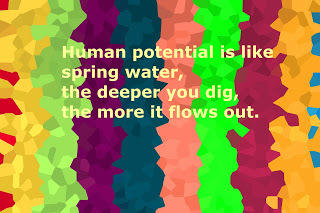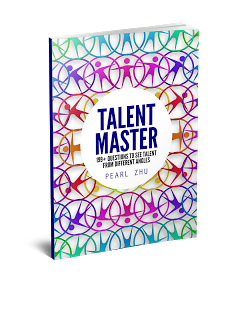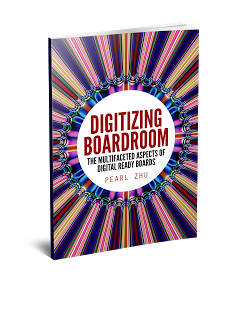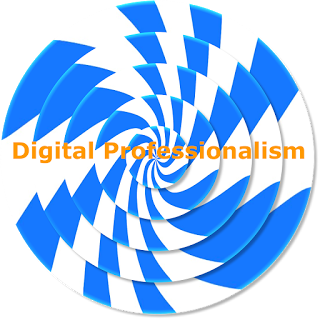Pearl Zhu's Blog, page 1306
August 18, 2016
“Talent Master” Book Conclusion: Talent Management Innovation
 Digital is the age of people, people are always the most valuable human asset and capital investment in any business, but often the weakest link in Digital Transformation. The static and often “one size fit all” traditional talent management and performance management have obvious weak spots to manage the dynamic digital workforce today. It’s strategic imperative for top business leaders and talent managers to see talent from different angles, and for digital professionals to keep digital fitness, enforce digital creativity, build digital intelligence, improve digital professionalism, and unleash their full potential. The goal of Talent Management innovation is to build a creative working environment, encourage change and inspire innovation, with the ultimate goal to maximize the future potential of the business as well.
Digital is the age of people, people are always the most valuable human asset and capital investment in any business, but often the weakest link in Digital Transformation. The static and often “one size fit all” traditional talent management and performance management have obvious weak spots to manage the dynamic digital workforce today. It’s strategic imperative for top business leaders and talent managers to see talent from different angles, and for digital professionals to keep digital fitness, enforce digital creativity, build digital intelligence, improve digital professionalism, and unleash their full potential. The goal of Talent Management innovation is to build a creative working environment, encourage change and inspire innovation, with the ultimate goal to maximize the future potential of the business as well.
Leveraging the advanced digital mindset, the latest digital technologies, and updated methodology to invest talent wisely: The traditional hiring or training programs are often outdated due to silo thinking and overly rigid processes which stifle innovation. There is too much focus on searching for static knowledge and maintaining the cost, not done enough to capture insight and build talent competency for the business’s long-term strategy. Talent managers should have an in-depth understanding of people as “WHO they are,” develop them, growth them and well-align their career goals with strategic organizational goals to achieve business prosperity. It will also improve employee engagement and they will put extra effort for solving problems creatively.
 Accelerate employees to the top of Maslow’s pyramid: According to Maslow, once a person has fulfilled a need for one layer, they will move up the higher level. If you are going to motivate people, besides compensation, fair and consistent talent management should be in place, acceptance, appreciation and affiliation can attract talent to have the sense of belonging. There needs to be a better appreciation for problem-solving abilities, to examine a situation from multiple angles and develop new approaches for the old problems. At the digital era, the new generations of workers pursue freedom, independence, and autonomy, at the highest level, to find meaning, purpose, and mastering of work, so talent management should accelerate such changes.
Accelerate employees to the top of Maslow’s pyramid: According to Maslow, once a person has fulfilled a need for one layer, they will move up the higher level. If you are going to motivate people, besides compensation, fair and consistent talent management should be in place, acceptance, appreciation and affiliation can attract talent to have the sense of belonging. There needs to be a better appreciation for problem-solving abilities, to examine a situation from multiple angles and develop new approaches for the old problems. At the digital era, the new generations of workers pursue freedom, independence, and autonomy, at the highest level, to find meaning, purpose, and mastering of work, so talent management should accelerate such changes.
Encourage cross-functional communication and collaboration: Digital is the age of innovation, which is not only about connecting the dots within a functional box but often more effectively across the functional boxes, even across businesses and industries. Hence, people have to work more closely with other functions in order to provide tailored talent solutions across business ecosystem. To innovate talent management, IT and hR should work hand-in-hand to manage information, analyze talent trend and capture business insight, then coupled with the personal touch, engagement, resolution, and development can follow. There is an increasing strategic importance of talent management innovation and how some HR processes need to be transformed into digitized business processes which underpin innovation capability of the organization.
Talent management innovation can only be achieved via innovative leadership, integrated process and creative & self-driven employees. The organizational talent management, performance management, knowledge management and culture management need to be integrated into a holistic people management solution in order to build a cohesive business capability for adapting changes, improving employee satisfaction and productivity and unleash talent potentials as well as the collective human potentials of your organization and our society.Follow us at: @Pearl_Zhu
Published on August 18, 2016 23:00
CIOs’ Q&As for IT Digital Transformation
 Nowadays information is overloading and technologies are permeating into every corner of the organization. IT plays a significant role in business growth and innovation. However, in reality, the majority of IT organizations still get stuck at the lower level of IT maturity with the reputation as a back-office support function and cost center. CIOs as business strategists and senior executives, which questions should you self-check or ask around (business, customers, employees, etc.) in order to improve IT agility and maturity?
Nowadays information is overloading and technologies are permeating into every corner of the organization. IT plays a significant role in business growth and innovation. However, in reality, the majority of IT organizations still get stuck at the lower level of IT maturity with the reputation as a back-office support function and cost center. CIOs as business strategists and senior executives, which questions should you self-check or ask around (business, customers, employees, etc.) in order to improve IT agility and maturity?
Q: Are IT goals (both at strategic and operational level) clear and achievable? CIOs have to have a clear and big picture of the company’s core business and strategy goals, if not, the IT organization may not be ready to work in new ways, or to be able to change in a short time. The well-communicated, clear defined goals and strategy mapping can help IT gain business respect. With such a volatile global marketplace, it’s time to consider how the business and IT can work together to make IT a differentiator between being midrange or top of your game. Regardless what you call it (alignment, collaboration, integration, engagement or harmony, etc), the top management team should work on identifying opportunities for enhancing IT-business relationship and clarify strategies and business goals. It’s time for IT to make the leap from functional or enabler to transform, working with the business to create a new leaner business model. A leap that will see IT working together with the business to build a stronger business, a business based on performance, growth, and agility.Q: Why is IT still being treated as a supporting function? And how to promote IT as a competitive advantage? CIOs should collect feedback from business partners on how they perceive IT, and what IT can do to improve reputation and promote IT as a competitive advantage. There are two sides of problems. One of the issues is that that business executive still limits their vision of IT as “IT supports a strategy,” CIOs role as C-level is to contribute to the formulation of the business strategy where new trends of digital technologies will provide strategic business capabilities to the business that will enhance the competitive advantages of the organization. CIOs need to share their view of the company strategies and the strategies in their group, how their group works with other groups, or if any frictions existing, CIOs needs to bridge the knowledge gaps of business executives to the trends of new technology and its impact on the business. CIOs should have the knowledge and ability to demonstrate that IT capabilities as a strategic enabler of the business. The main role of the CIO is to demonstrate to the other executives the added value provided by technology using the business language (as businesses cases). CIOs should understand the business first, otherwise, it is challenging to link the dot between business and IT. Once you show and demonstrate to the other CxOs that you understand the business they will respect you and give you authority, power, and influence in executive decision-making and strategy management.What are CIOs’ best and next practices to build business capabilities and implement capability-based strategy smoothly? The business capability is at a higher level than business process. The core business capabilities are an integrated set of capabilities contribute directly to the competitive advantage of the business and directly impact the success rate of strategy execution. IT is the key component of the business capabilities. Organizational capabilities that exist and the need to be developed, both for necessity and competitive advantage. IT is not just the sum of services or processes, or monolithic hardware only, IT needs to build a set of value-added digital capabilities via weaving all necessary hard and soft elements, in reaching high-level maturity. Q: How do business leaders/ users believe decisions are made and how they make them - and how can IT help provide the right information to the right people to make the right decisions at the right time? Information applies to the context and environment in which decisions are made. Information, with the inclusiveness of data as input, is primary drivers of decisions when they apply to automated systems, not human beings. In order to make effective and timely decisions, one of the prerequisites is to recognize your own frame of reference prior to making any decision. Achieving such awareness through serious self-reflection frees you from the habituated 'scripts,' and allows you to see new possible options before decisions are made. Hence, collecting necessary information is an important step in making an objective decision, both analysis and intuition are important in making objective decisions. In the human context, information drives awareness, which can include all of these characteristics, uncertainty, surprise, difficulty and entropy, although it can also trigger a sense of confidence, confirmation, validation, verification. In the organizational context, IT plays an important role as an information steward to provide the right information to the right people to make the right decisions at the right time.
 Q: How do IT leaders measure success, and then pull together the thoughts on the gaps, priorities, disconnects, and needs that exist across the organizations? Historically, performance measurement systems for most businesses have been financing driven. However, in many business situations, financial indicators only cover part of the story. Your measures should cover all areas that contribute to value creation it’s dangerous to impose metrics just because the focus on what’s measurable is manageable. IT leaders must keep in mind which KPIs best measure IT ability to deliver business value. Continually accelerating changes in IT consumption and production requires faster responses and better performance metrics. IT Metrics has to evolve from being a cost center to becoming a revenue generator. The only way to do this is to show a clear link to top executives between IT efficiency and productivity/ top-line revenues. This is an important step to building IT reputation as a strategic business partner.
Q: How do IT leaders measure success, and then pull together the thoughts on the gaps, priorities, disconnects, and needs that exist across the organizations? Historically, performance measurement systems for most businesses have been financing driven. However, in many business situations, financial indicators only cover part of the story. Your measures should cover all areas that contribute to value creation it’s dangerous to impose metrics just because the focus on what’s measurable is manageable. IT leaders must keep in mind which KPIs best measure IT ability to deliver business value. Continually accelerating changes in IT consumption and production requires faster responses and better performance metrics. IT Metrics has to evolve from being a cost center to becoming a revenue generator. The only way to do this is to show a clear link to top executives between IT efficiency and productivity/ top-line revenues. This is an important step to building IT reputation as a strategic business partner. There are many more questions IT leaders should ask, and they also should be open minded to enjoy “out of box” thinking with alternative answers to spark innovation. Also because, there’s really no standard answers for most of questions. IT is not just part of the business; it is a critical, integral component of the business. When a CIO is able to position and maintain the IT organization to ensure it addresses both IT effectiveness and efficiency, agility and innovation, flexibility and scalability, they have earned their stripes.
Follow us at: @Pearl_Zhu
Published on August 18, 2016 22:57
August 17, 2016
The Monthly Innovation Brief: Who are those Innovators Aug. 2016
 Innovation takes a cycle of observing-questioning-connecting-networking-experimenting. From a management perspective, innovation is how to transform novel ideas to achieve its business value. Due to hyper-complexity of modern business, innovation is essentially about reducing the unnecessary business complexity to tackle the complexities of business dynamic. And the leadership in any organization must have the ability to guide, inspire, innovate, and motivate a group of people toward accomplishing shared visions and goals. But who are the innovators, and what are important elements in innovative leadership though?
Innovation takes a cycle of observing-questioning-connecting-networking-experimenting. From a management perspective, innovation is how to transform novel ideas to achieve its business value. Due to hyper-complexity of modern business, innovation is essentially about reducing the unnecessary business complexity to tackle the complexities of business dynamic. And the leadership in any organization must have the ability to guide, inspire, innovate, and motivate a group of people toward accomplishing shared visions and goals. But who are the innovators, and what are important elements in innovative leadership though?
Who are those Innovators
An Innovator’s Scoreboard Innovation is about transforming novel ideas into business values. Innovation score means an attempt to measure innovation; so the factors included in any scoring system will depend on what you are looking to evaluate (individual vs. organization? potential vs. past performance?), this is usually done through innovation indicators. What’re the pros and cons of measuring innovation and score innovators
The T-Shaped Talent with Innovative Thinking With the border between different functions or disciplines continue blurring, the specialized generalists are in strong demand, or we normally call the “T-Shape” talent, and the innovative thinker -you start with a strong T and then sprinkle heavy dots randomly across the graph with varying strengths of lines connecting them and the occasional pulsing outlier dot. How do T-shaped people feel? What are their emotional strengths and weaknesses? What is their ability to make sense of a situation? Does this "profile-metaphor" take into account fit and affinity, rapport and empathy? Why is T-shaped talent so popular, and how to groom such type of talent??
Top Qualities & Skills of Innovation Leaders? There are many common leadership qualities or skills shared between an innovative leader and any good leader or any creative team member. However, being innovative leaders take more courage, creativity, courage, collaboration, and concentration.
Three Traits of Innovative Team Due to the complexity of today’s business dynamic, more often than not, innovation is a teamwork, rather than just an individual’s effort, what are the successful traits of an innovative team, and how to improve the team’s innovation fluency?
Shall you Assess Talent's 'Creatibility'?Traditional performance management in most of the organizations usually focuses on measuring employees’ efficiency: are they doing what being told to do well. However, with increasing competition and emergent business changes, should organizations today also assess their talent from innovation angle, in order to cultivate a culture of innovation and improve business competency, if so, HOW, what’re the technique or best practices can be shared?
Why ‘Good Managers’ are not always Good for Innovation Modern managers are pillars of running complex businesses, good managers are disciplined, dedicated and accountable, however, in many cases, why good managers are not always good for innovation, what’re the issues, how to flex innovation muscles in the management team?
 Can Employees Learn to Be Innovative? Innovation is the light every forward-looking organization is pursuing; however, business’s innovation capability depends on its people, the team of talent who can transform novel idea to achieve its commercial value. How should organizations train their staff to become more creative? And can employee learn to be innovative?The “Future of CIO” Blog has reached 1.5 million page views with about 3000+ blog posting in 59+ different categories of leadership, management, strategy, digitalization, change/talent, etc. The content richness is not for its own sake, but to convey the vision and share the wisdom. Blogging is not about writing, but about thinking; it’s not just about WHAT to say, but about WHY to say, and HOW to say it. It reflects the color and shade of your thought patterns, and it indicates the peaks and curves of your thinking waves. Unlike pure entertainment, quality and professional content takes time for digesting, contemplation and engaging, and therefore, it takes the time to attract the "hungry minds" and the "deep souls." It’s the journey to amplify your voice, deepen your digital footprints, and match your way for human progression.
Can Employees Learn to Be Innovative? Innovation is the light every forward-looking organization is pursuing; however, business’s innovation capability depends on its people, the team of talent who can transform novel idea to achieve its commercial value. How should organizations train their staff to become more creative? And can employee learn to be innovative?The “Future of CIO” Blog has reached 1.5 million page views with about 3000+ blog posting in 59+ different categories of leadership, management, strategy, digitalization, change/talent, etc. The content richness is not for its own sake, but to convey the vision and share the wisdom. Blogging is not about writing, but about thinking; it’s not just about WHAT to say, but about WHY to say, and HOW to say it. It reflects the color and shade of your thought patterns, and it indicates the peaks and curves of your thinking waves. Unlike pure entertainment, quality and professional content takes time for digesting, contemplation and engaging, and therefore, it takes the time to attract the "hungry minds" and the "deep souls." It’s the journey to amplify your voice, deepen your digital footprints, and match your way for human progression.Follow us at: @Pearl_Zhu
Published on August 17, 2016 23:30
The Book “Talent Master” Chapter 5 Introduction: Digital Potential
 People are always the most invaluable asset the business should invest in, but most organizations still use static mechanisms to measure talent performance mainly based on quantitative delivery, with ignorance of qualitative perspective, talent potential assessment, intangible culture impact, or lack of overall holistic talent management and tailored performance management of lifting up the next level of people management maturity. For example, how to differentiate potential from performance, how to unleash the collective human potential to innovate your business and advance our society?
People are always the most invaluable asset the business should invest in, but most organizations still use static mechanisms to measure talent performance mainly based on quantitative delivery, with ignorance of qualitative perspective, talent potential assessment, intangible culture impact, or lack of overall holistic talent management and tailored performance management of lifting up the next level of people management maturity. For example, how to differentiate potential from performance, how to unleash the collective human potential to innovate your business and advance our society?
Performance vs. Potential: Performance is well done of current assignments and demonstrated the capacity of doing good work with the quantitative result. However, do not assume though that top performer is the top talent for the future. The high performer may be at the top of their game at the moment, but the question is how well will they adapt to changes, be learning agile to enhance their innate capability. This is where the potential comes into play. Potential is about future performance, not past performance. How well does an individual continue to grow, how likely can they take on new challenges at work, rapidly learn and grow into next-level roles, or roles that are expanded and redefined as the business changes? The one thing to differentiate talented people, either high performance or high potential from mediocrity is MINDSET, which further drives attitude. The worst mediocrity is not the mediocre result, but a mediocre attitude, which often brings negative, professionalism, or lower team morality. Unfortunately, in some organizations, mediocrity get encouraged or even rewarded, and ultimately drag the whole business down to irrelevant.
Strengthen your strength: Every person is unique and we all have our own strength and weakness. Knowing who you are or being self-awareness, allows you to become a higher quality digital professional. Be self-aware, be able to see our strengths and weaknesses without self-judgment is possible and healthy. Knowing who you are and how you react and respond in a different situation can help you understand and improve cognitive, relational and assertive actions you take on a day to day basis, understanding your strength also helps you to unleash your full potential and better manage your professional life in the long run. From digital talent management lenses, social analysis helps pinpoint to who knows what within within or even beyond your organization based on social influence and thought leadership, it allows organizations to identify the strength of talented people, and enable forward-looking organizations to build the alternative digital talent pipeline and put the right people in the right positions.
 Motivational potential: Motivation is having a passion or drive for achievement and continuous improvement. Motivation is moving forward, taking action. Motivation requires giving someone a “motive,” usually self-interest along the lines. Assessing a person’s motivational potential is how well he or she can adapt personal drive and focus on performing well in new and changing context (self-motivation). Being motivated has both push and pull factors. You are motivated to move away from something because it’s painful and also moves towards something which is inspiring. So inspiration is the “pull” factor in the continuum of motivation. Motivation is on the ground and immediate level, it can be either a carrot or the stick. But the only one who can motivate you is YOU. You have to have the desire and be willing to challenge yourself to be all you can be. Motivation is to drive action for winning, but better with a purpose.
Motivational potential: Motivation is having a passion or drive for achievement and continuous improvement. Motivation is moving forward, taking action. Motivation requires giving someone a “motive,” usually self-interest along the lines. Assessing a person’s motivational potential is how well he or she can adapt personal drive and focus on performing well in new and changing context (self-motivation). Being motivated has both push and pull factors. You are motivated to move away from something because it’s painful and also moves towards something which is inspiring. So inspiration is the “pull” factor in the continuum of motivation. Motivation is on the ground and immediate level, it can be either a carrot or the stick. But the only one who can motivate you is YOU. You have to have the desire and be willing to challenge yourself to be all you can be. Motivation is to drive action for winning, but better with a purpose. From people management perspective, how to unleash the abundance of human potential is perhaps one of the best rewarding fields for the human society advancement, but is is the arena still full of myth. Tapping the unlimited human potential is both art and science, it takes out of box thinking and trans-disciplinary approach. Follow us at: @Pearl_Zhu
Published on August 17, 2016 23:25
“CIO Master” Book Tuning: Three Aspects of IT Performance Management
 Traditional IT organizations were running inside-out operation driven, CIOs and technique managers assess IT performance via the lenses of IT, and mainly about “keeping the business bottom line.” Hence, business partners perceive IT as a cost center, or support center, because they don’t have a clear picture with quantitative information about contemporary IT value proposition, and thus, lack of knowledge on how critical IT contributes to the business’s top-line growth and customer satisfaction. Managing performance means understanding results, setting metrics, fixing plans, and making decisions to ensure it happens. In order to reinvent the tarnished reputation of IT, how to manage IT performance effectively via selecting key indicators, measuring both the right things and measuring them in the right way? IT Value Indicator: IT metrics need to evolve to something that matters to the business audience, at the same time that "business sentiment" needs to get put into something more tangible, such as optimize processes, or improve productivity. Every new technology adopted must facilitate business but also bring down the incremental cost of growth and the time to market. That should be the true metric for a CIO’s success – how has he/she been able to impact the top and bottom-line and facilitate growth and competitiveness.These are undoubtedly dynamic times, with increasing speed of changes and high expectation of customers due to IT consumerization trends, the fundamentals of a business seldom change. From IT performance perspective, measure what it matters, to reflect the business value, also make sure IT and business are always on the same page. It almost sounds like a “business dialect translation” issue - two different languages or cultures that need to find a common ground. Measure IT performance through the benchmark which can reflect IT value to the business, not only for the bottom line but also for top line growth.
Traditional IT organizations were running inside-out operation driven, CIOs and technique managers assess IT performance via the lenses of IT, and mainly about “keeping the business bottom line.” Hence, business partners perceive IT as a cost center, or support center, because they don’t have a clear picture with quantitative information about contemporary IT value proposition, and thus, lack of knowledge on how critical IT contributes to the business’s top-line growth and customer satisfaction. Managing performance means understanding results, setting metrics, fixing plans, and making decisions to ensure it happens. In order to reinvent the tarnished reputation of IT, how to manage IT performance effectively via selecting key indicators, measuring both the right things and measuring them in the right way? IT Value Indicator: IT metrics need to evolve to something that matters to the business audience, at the same time that "business sentiment" needs to get put into something more tangible, such as optimize processes, or improve productivity. Every new technology adopted must facilitate business but also bring down the incremental cost of growth and the time to market. That should be the true metric for a CIO’s success – how has he/she been able to impact the top and bottom-line and facilitate growth and competitiveness.These are undoubtedly dynamic times, with increasing speed of changes and high expectation of customers due to IT consumerization trends, the fundamentals of a business seldom change. From IT performance perspective, measure what it matters, to reflect the business value, also make sure IT and business are always on the same page. It almost sounds like a “business dialect translation” issue - two different languages or cultures that need to find a common ground. Measure IT performance through the benchmark which can reflect IT value to the business, not only for the bottom line but also for top line growth.
IT Innovation Indicator (end customer retention, revenue growth): Digital is the age of innovation and customer centricity. IT metrics must get focused on the end-users. The end-user continues to be the key component of any customer-centric business.This is where the metrics for a CIO should rest – the end-user experience. To measure innovation, you choose those KPIs by deciding which are seen as critical to making progress on in order to deliver more innovations. The fewer the better, but they have to be credible and relevant also in the eyes of the stakeholders. For example, how much revenue is generated by innovations launched in the last 3-5 years? Are innovation failures caused by the time lag, inefficiency of financial systems? Normally organizations look for KPIs measuring business results generated by innovation efforts. But it takes quite some time for a new innovation drive to produce those measures. One of the solutions is to define process KPIs, which demonstrate the growing capability of the organization to deliver more innovation with business impact in the future.
 IT Investment Indicator (long term vision & strategy vs. quick win, low hanging fruit etc): Performances are not just numbers with metrics, they are numbers in context, results related to your strategic GOALS. As for success metrics, metrics, either new or old - for success will be predicated on the strategy and sourcing model. If the business strategy is an early adopter and rewards innovation which is an important component of the business strategy, then the metrics have to accommodate IT investment outcomes that may have a higher level of value than that of a laggard who focuses on efficiency- picking the low hanging fruit only. New competitive challenges and active market changes underscore the strategic imperative of managing performance more than ever. The well-selected IT investment indicators will help management make effective decisions on IT-enabled business innovation and information management for achieve high performance and driving long-term growth.
IT Investment Indicator (long term vision & strategy vs. quick win, low hanging fruit etc): Performances are not just numbers with metrics, they are numbers in context, results related to your strategic GOALS. As for success metrics, metrics, either new or old - for success will be predicated on the strategy and sourcing model. If the business strategy is an early adopter and rewards innovation which is an important component of the business strategy, then the metrics have to accommodate IT investment outcomes that may have a higher level of value than that of a laggard who focuses on efficiency- picking the low hanging fruit only. New competitive challenges and active market changes underscore the strategic imperative of managing performance more than ever. The well-selected IT investment indicators will help management make effective decisions on IT-enabled business innovation and information management for achieve high performance and driving long-term growth.
In the end, the business expects ROI. The answer upon how to measure properly is somewhere in the middle. Bottom line ROI and financial analysis are a great way to evaluate a new product or change to an existing system. But the various activities needed to manage performance— STRATEGIC and OPERATIONAL plans, METRICS, day-to-day decisions. Your measures should cover all areas that contribute to value creation including service quality, employee engagement, customer satisfaction, innovation, and financial outcomes.
Follow us at: @Pearl_Zhu
Published on August 17, 2016 23:19
“Digitizing Boardroom - The multifaceted Aspects of Digital-Ready Boards” Book Preview
A highly effective and wise Board exhibits a creative tension, that hard to define, but you know it when you see it.
 Modern corporate boards play significant roles in guiding businesses toward the right direction and achieve expected business results. Due to the “VUCA” characteristics -Complexity, Uncertainty, Ambiguity and Velocity of the Digital Era, the directorship in any organization must have the agility to adapt to changes, and build abilities to advise, inspire and motivate a group of people toward accomplishing shared visions and goals. If a Board is to fulfill its fiduciary responsibilities to its stakeholders, it needs to take a professional and systematic approach for assessing strategy, prioritizing agendas, advising changes, overseeing risks and keeping track of business performance via efficient tools. BoDs perhaps do not always participate in developing business strategy, but the Board needs to determine suitability, adequacy, viability, and sustainability of the organization in advance.
Modern corporate boards play significant roles in guiding businesses toward the right direction and achieve expected business results. Due to the “VUCA” characteristics -Complexity, Uncertainty, Ambiguity and Velocity of the Digital Era, the directorship in any organization must have the agility to adapt to changes, and build abilities to advise, inspire and motivate a group of people toward accomplishing shared visions and goals. If a Board is to fulfill its fiduciary responsibilities to its stakeholders, it needs to take a professional and systematic approach for assessing strategy, prioritizing agendas, advising changes, overseeing risks and keeping track of business performance via efficient tools. BoDs perhaps do not always participate in developing business strategy, but the Board needs to determine suitability, adequacy, viability, and sustainability of the organization in advance.
The main purpose of book “Digitizing Boardrooms -The Multifaceted Aspects of Digital Ready Board” is to Envision the future of directorship with twenty-three digital boardroom themes.Oversee business strategies with digital fluidity, digital mindset, and contextual intelligence.Make policies and effective decisions on transforming boards from conformance to performance driven.Rejuvenate boardrooms via participating in both innovation management and management innovation.Highlight the importance of building IT friendly and technology-savvy digital boards.Develop the best and next governance practices towards achieving corporate excellence.Advocate digital fitness and innovate people management to become “Talent Master.” Set digital culture tones, and fine-tune processes to make boards highly effective and highly mature.
 The modern digital board has many responsibilities, also gets a lot of distractions. It has to laser focus on the most critical perspectives to steering the business toward the right decision. BoDs are leadership roles, they should not only oversee business strategies and monitor business performance but also set the tone for the culture, become talent masters, they should walk the talk to become more learning agile, information savvy and innovative to adapt to the digital dynamic. A highly effective and wise Board exhibits a creative tension, that hard to define, but you know it when you see it. Follow us at: @Pearl_Zhu
The modern digital board has many responsibilities, also gets a lot of distractions. It has to laser focus on the most critical perspectives to steering the business toward the right decision. BoDs are leadership roles, they should not only oversee business strategies and monitor business performance but also set the tone for the culture, become talent masters, they should walk the talk to become more learning agile, information savvy and innovative to adapt to the digital dynamic. A highly effective and wise Board exhibits a creative tension, that hard to define, but you know it when you see it. Follow us at: @Pearl_Zhu
 Modern corporate boards play significant roles in guiding businesses toward the right direction and achieve expected business results. Due to the “VUCA” characteristics -Complexity, Uncertainty, Ambiguity and Velocity of the Digital Era, the directorship in any organization must have the agility to adapt to changes, and build abilities to advise, inspire and motivate a group of people toward accomplishing shared visions and goals. If a Board is to fulfill its fiduciary responsibilities to its stakeholders, it needs to take a professional and systematic approach for assessing strategy, prioritizing agendas, advising changes, overseeing risks and keeping track of business performance via efficient tools. BoDs perhaps do not always participate in developing business strategy, but the Board needs to determine suitability, adequacy, viability, and sustainability of the organization in advance.
Modern corporate boards play significant roles in guiding businesses toward the right direction and achieve expected business results. Due to the “VUCA” characteristics -Complexity, Uncertainty, Ambiguity and Velocity of the Digital Era, the directorship in any organization must have the agility to adapt to changes, and build abilities to advise, inspire and motivate a group of people toward accomplishing shared visions and goals. If a Board is to fulfill its fiduciary responsibilities to its stakeholders, it needs to take a professional and systematic approach for assessing strategy, prioritizing agendas, advising changes, overseeing risks and keeping track of business performance via efficient tools. BoDs perhaps do not always participate in developing business strategy, but the Board needs to determine suitability, adequacy, viability, and sustainability of the organization in advance.
The main purpose of book “Digitizing Boardrooms -The Multifaceted Aspects of Digital Ready Board” is to Envision the future of directorship with twenty-three digital boardroom themes.Oversee business strategies with digital fluidity, digital mindset, and contextual intelligence.Make policies and effective decisions on transforming boards from conformance to performance driven.Rejuvenate boardrooms via participating in both innovation management and management innovation.Highlight the importance of building IT friendly and technology-savvy digital boards.Develop the best and next governance practices towards achieving corporate excellence.Advocate digital fitness and innovate people management to become “Talent Master.” Set digital culture tones, and fine-tune processes to make boards highly effective and highly mature.
 The modern digital board has many responsibilities, also gets a lot of distractions. It has to laser focus on the most critical perspectives to steering the business toward the right decision. BoDs are leadership roles, they should not only oversee business strategies and monitor business performance but also set the tone for the culture, become talent masters, they should walk the talk to become more learning agile, information savvy and innovative to adapt to the digital dynamic. A highly effective and wise Board exhibits a creative tension, that hard to define, but you know it when you see it. Follow us at: @Pearl_Zhu
The modern digital board has many responsibilities, also gets a lot of distractions. It has to laser focus on the most critical perspectives to steering the business toward the right decision. BoDs are leadership roles, they should not only oversee business strategies and monitor business performance but also set the tone for the culture, become talent masters, they should walk the talk to become more learning agile, information savvy and innovative to adapt to the digital dynamic. A highly effective and wise Board exhibits a creative tension, that hard to define, but you know it when you see it. Follow us at: @Pearl_Zhu
Published on August 17, 2016 23:15
August 16, 2016
The Monthly Innovation Brief: The Best/Next Practices in Innovation Management Aug. 2016
 Innovation takes cycle of observing-questioning-connecting-networking-experimenting. From management perspective, innovation is how to transform novel ideas to achieve its business value, due to the hyper-complexity of modern business, innovation is essentially about reducing the unnecessary business complexity to tackle the complexities of business dynamic. Here is a series of blogs to brainstorm the practices of innovation management.
Innovation takes cycle of observing-questioning-connecting-networking-experimenting. From management perspective, innovation is how to transform novel ideas to achieve its business value, due to the hyper-complexity of modern business, innovation is essentially about reducing the unnecessary business complexity to tackle the complexities of business dynamic. Here is a series of blogs to brainstorm the practices of innovation management.
The Best/Next Practices in Innovation ManagementWhat are the Best/Next Practices to Keep Innovation Alive in a Company? Innovation is to transform novel ideas to achieve its business value. It is very important to recognize that innovation is an essential factor for a company’s long-term success. However, becoming a truly innovative company is difficult, due to the risks involved and management skills needed. Some might complain innovation has distracted them from their strategic focus, the fact is that innovation is an important element of your business strategy, so the problem is how you can keep innovation alive in your organization?
Innovation Best Practice: Practical or Contradictory Innovation is how to transform the novel ideas and achieve its commercial values. Due to the open nature and “out of box” thinking of innovation, is it contradictory to do that inside of the constraints of "best practices"? Is there actually anyone using what to be considered the 'best practice' in innovation in reality? Does best practice really improve innovation success rate or increase innovation efficiency??
How to Practice Creativity by Questioning As saying’s going: there is no such thing as a stupid question - ask and ask some more. A creative mind is more often inquisitive, ask many questions, the 'right' and well thought out question is halfway to attaining the right answer. Creativity is the soaring factor in growing into a Digital Master.
How to Well Tune the organizational Structure for Breakthrough Innovation? Innovation is to transform novel ideas and achieve its business value. However, for most of organizations, innovation, especially breakthrough innovation, is still a serendipity. There are many factors to decide innovation success. From an organizational structure perspective, how can you get well organized for managing innovation more effectively?
 Running IT as an Innovation Engine in Digital Organizations? Organizations large or small are at the digital journey, and corporate IT is also shifting from a support center to an innovation engine, because more often information is the lifeblood, and technology is the disruptor to push the business world into the digital paradigm. Hence, for any forward-thinking organizations, IT mantra is shifting from “doing more with less,” to “doing more with innovation. But more specifically, how to run IT as an innovation engine to accelerate digital shift?
Running IT as an Innovation Engine in Digital Organizations? Organizations large or small are at the digital journey, and corporate IT is also shifting from a support center to an innovation engine, because more often information is the lifeblood, and technology is the disruptor to push the business world into the digital paradigm. Hence, for any forward-thinking organizations, IT mantra is shifting from “doing more with less,” to “doing more with innovation. But more specifically, how to run IT as an innovation engine to accelerate digital shift?The “Future of CIO” Blog has reached 1.5 million page views with about 3000+ blog posting in 59+ different categories of leadership, management, strategy, digitalization, change/talent, etc. The content richness is not for its own sake, but to convey the vision and share the wisdom. Blogging is not about writing, but about thinking; it’s not just about WHAT to say, but about WHY to say, and HOW to say it. It reflects the color and shade of your thought patterns, and it indicates the peaks and curves of your thinking waves. Unlike pure entertainment, quality and professional content takes time for digesting, contemplation and engaging, and therefore, it takes time to attract the "hungry minds" and the "deep souls." It’s the journey to amplify your voice, deepen your digital footprints, and match your way for human progression.Follow us at: @Pearl_Zhu
Published on August 16, 2016 23:15
The New Book “Talent Master” Chapter IV Introduction: Digital Professionalism
 Digital workforce and workplace are more diverse and dynamic than ever today, they are multi-generational, multi-cultural, and multi-devicing. The talent management goal of an organization is to find out how you can locate the right candidate with the right capability for a right position within an organization to unleash potential and achieve high performance. However, from a wide variety of talent management surveys, unprofessionalism is still pervasive, it is the big barrier to building a culture of innovation, damages the business reputation and tarnishes the trust of modern businesses and society. Hence, how to assess employees’ professionalism, help them shape the right mindset, build high-performing business culture and improve the organizational effectiveness and maturity?
Digital workforce and workplace are more diverse and dynamic than ever today, they are multi-generational, multi-cultural, and multi-devicing. The talent management goal of an organization is to find out how you can locate the right candidate with the right capability for a right position within an organization to unleash potential and achieve high performance. However, from a wide variety of talent management surveys, unprofessionalism is still pervasive, it is the big barrier to building a culture of innovation, damages the business reputation and tarnishes the trust of modern businesses and society. Hence, how to assess employees’ professionalism, help them shape the right mindset, build high-performing business culture and improve the organizational effectiveness and maturity?
High-quality professionals look decently, think profoundly, and act thoughtfully: Being professional means you present a certain quality that shows a high level of excellence & value, peculiar and essential character. We are what we think, the quality of a person is often decided by the quality of his/her thoughts, attitudes, and behaviors. High quality digital leaders or professionals are great in altitude, aptitude, and attitude -a winning mixture composed of intelligence and competence, confidence and humility, self-esteem and high EQ. They are also made of personal qualities such as positive thinking, critical thinking, independent judgment, a sense of responsibility and respect (both respect others and being respected). High-quality leaders and employees make positive influences on corporate culture and bring wisdom to the workplace.
High-professionalism means authenticity: Nobody is perfect, we all have strength and weakness, focus or preference. Being authentic means being true to that in different aspect: thinking, saying and doing with consistency. Being consistent during the good and tough moments is particularly difficult for leaders as they advance in their career, it means that you have clear visions and coherent thoughts to lead forward even the time flow. The high-quality professionals sometimes also make mistakes, but they have learning attitude o focus on solving problems, not finger point, and they are able to learn from every experience, understand the context, have work ethics and dealing with situation intelligently and consistently.
 High-professionalism also means maturity which is not always associated with age but having a sound understanding of basics and make fair judgments. It is the clarity of thoughts along with self-control which helps in choosing the most appropriate reaction of inaction. It’s the ability to weigh in the impact of what we are planning to do and responding to every situation according to its severity level. Intellectual maturity also means to have the ability to live comfortably with contradictory thoughts, and expressing things courageously by taking care of the feelings of the other people empathetically. Communicate thoroughly, but not winning a small battle of ego. When a person knows the principles of life and has well crated to great level of mindfulness, competencies, or skills, the person becomes fully developed and thus has achieved maturity with is the combination of capability and potentiality.
High-professionalism also means maturity which is not always associated with age but having a sound understanding of basics and make fair judgments. It is the clarity of thoughts along with self-control which helps in choosing the most appropriate reaction of inaction. It’s the ability to weigh in the impact of what we are planning to do and responding to every situation according to its severity level. Intellectual maturity also means to have the ability to live comfortably with contradictory thoughts, and expressing things courageously by taking care of the feelings of the other people empathetically. Communicate thoroughly, but not winning a small battle of ego. When a person knows the principles of life and has well crated to great level of mindfulness, competencies, or skills, the person becomes fully developed and thus has achieved maturity with is the combination of capability and potentiality. From people management perspective, in order to strengthen the weakest link -people and advocate high professionalism, organizations should integrate performance management, talent management, culture management and knowledge management into a holistic approach to get people digital ready, build a culture of innovation, drive corporate mindset, attitude, capability and long-term achievement. Follow us at: @Pearl_Zhu
Published on August 16, 2016 23:12
Three Syndromes Decelerating Digital Transformation of IT
 Forward-looking organizations are on the journey of digital transformation. Information technology is penetrating into every core process of the organization; how agile the organization can adapt to changes and how smart the organization can capture business insight are often dependent on how effective the company can manage information Management. Hence, IT as the information steward of the business plays a crucial role in business growth and innovation. But what are pitfalls on the way to stop IT from reinventing itself, and which syndromes could cause decelerate the digital transformation of IT.
Forward-looking organizations are on the journey of digital transformation. Information technology is penetrating into every core process of the organization; how agile the organization can adapt to changes and how smart the organization can capture business insight are often dependent on how effective the company can manage information Management. Hence, IT as the information steward of the business plays a crucial role in business growth and innovation. But what are pitfalls on the way to stop IT from reinventing itself, and which syndromes could cause decelerate the digital transformation of IT.
“Lost in translation” syndrome: Through digital means hyperconnectivity and always on, some say the gaps between IT and business is indeed enlarged, because the different parts of the business involve digital transform with varying speed. The disconnect between the business and IT is still one of the root causes to fail IT and business as well. And it is often caused by miscommunication and lack of cross-functional collaboration. More specifically, “lost in translation” syndrome is caused by mistakes that most organizations make in business communication that fail to translate the high-level language of strategy into the professional language of the various staff specialty. What's missing in many organizations is the CIO's ability to question the business' requirements and justifications used for IT based projects. Many CIOs are still perceived as IT geeks who speak “different language,” from other executives, and they are shy away from asking insightful business-focused questions. In order to bridge the gaps, CIOs need to master different “business dialects,” and become business strategists. They also have to advocate for "departmental immersion" and other strategies to help IT become more integrated and aware of the organization as a whole. CIOs should have courage to admit if they don’t know something, because they are human and can not possibly know everything. It is totally fair not to know something at an instant, but to be able to research it and find the proper solution. That is usually an acceptable answer to the board of directors, peer group, staff and customers.
The “Short-sighted” IT syndrome: The reason most of IT organizations get stuck in the lower level of maturity is because they are busy on fixing the symptoms, or taking care of immediate problems, with ignorance of digging into the root cause of problems, and focusing on a longer term vision and strategy execution. CIOs should be far-sighted and be able to make the relationship at peer level in other departments so that they have knowledge of key business issues as well being member of the senior management and should be able to give his/her opinion/solution if being asked, and be aware of the key business issues. So IT won’t just “fix the symptoms,” but dig through the root cause of old or emergent business issues, and deliver the best solution to the business problems which meet the business’s requirement for the long run and tailor customer’s needs. IT can also proactively work as an integral part of the business to capitalize on opportunity via an in-depth understanding of the business and leading the transformation, not just from an IT perspective, but from the business's viewpoint.
 “Snooze-you-lose” syndrome: Many IT organizations get stuck in the lower level of maturity, and being perceived as a “slow to change” cost center, or put simply, suffering from a “snooze-you-lose” syndrome. With the emergent digital technological trends, businesses are reliant on IT as force multiplier and a cloud orchestrator, to accelerate changes, enhance agility and productivity, uncover customer insights, predict business trends, catalyze innovation, create new business models. It’s ultimately important for IT to discuss "what's possible" not just "what do you want." This requires a certain depth of understanding the business and having your input respected. The first is learned, the second is earned. Especially the "what is possible" part, don't just deliver what the business asks for, but be able to provide the "best solution" for the business' requirement, offering added value and feature insights based on system understanding, that the business might not even have thought of
“Snooze-you-lose” syndrome: Many IT organizations get stuck in the lower level of maturity, and being perceived as a “slow to change” cost center, or put simply, suffering from a “snooze-you-lose” syndrome. With the emergent digital technological trends, businesses are reliant on IT as force multiplier and a cloud orchestrator, to accelerate changes, enhance agility and productivity, uncover customer insights, predict business trends, catalyze innovation, create new business models. It’s ultimately important for IT to discuss "what's possible" not just "what do you want." This requires a certain depth of understanding the business and having your input respected. The first is learned, the second is earned. Especially the "what is possible" part, don't just deliver what the business asks for, but be able to provide the "best solution" for the business' requirement, offering added value and feature insights based on system understanding, that the business might not even have thought of
To avoid those “IT deceleration” syndrome, IT leaders have to transform from being tactical managers to business strategists, have business acumen, beyond technical knowledge. The CIO must be concerned as to whether the operational ecosystem will function as expected. Being authentic and present provides you with credibility to drive changes, and manage a balanced “run, grow, and transform” program portfolio, to accelerate the business’s digital transformation and bring high-performing business result.
Follow us at: @Pearl_Zhu
Published on August 16, 2016 23:07
August 15, 2016
The Monthly CIO Debates Collection: Tough Choices for Digital CIOs Aug., 2016
Debating is not for stimulating conflicts, but for brainstorming better ways to do things.
 Due to the changing nature of technology, IT leadership role also continues to involve & shift the focus, to move up the maturity level. More and more CIOs are requested to take more responsibility and many CIOs present the breadth of leadership competency. The proactive IT debates help IT leaders to brainstorm innovative and better ways to do things, and improve management capabilities. Here are the monthly CIO debates collections on Aug. 2016.
Due to the changing nature of technology, IT leadership role also continues to involve & shift the focus, to move up the maturity level. More and more CIOs are requested to take more responsibility and many CIOs present the breadth of leadership competency. The proactive IT debates help IT leaders to brainstorm innovative and better ways to do things, and improve management capabilities. Here are the monthly CIO debates collections on Aug. 2016.
Tough Choices for Digital CIOs Aug. 2016The Two Sides of IT: Which Side is More Important? The forward-looking IT organizations are on the journey of digital transformation. The challenge is having a harmonized vision about overall IT capabilities and maturities, and which role IT should, or can play in the digital organization. There are front end and back end of the IT department. The front end of IT is value-added, to drive the business’s digital transformation, and the back end of the IT is fundamental, operational driven and keep the lights on. From IT management and digital transformation perspective, how to run two sides of IT smoothly, via setting the right principles and developing the next practices?
As CIOs: Which IT Management Dilemmas Do you Encounter? Technology is pervasive, business initiatives, changes, and transformation today nearly always involve some form of technology implementation or information analysis; IT touches both hard business processes and soft human behaviors. However, managing a highly effective IT is not an easy job, IT leaders have to overcome many change management roadblocks and deal with quite a few of IT management dilemmas in transforming from a cost center to value creator, from a support function to a strategic business partner; from a back office to an innovation front yard.
Does Systems Thinking stifle creativity or not? Creativity is an inward process to produce the novel ideas and build unique value. Creativity is by definition an aspect to the emergent behavior that exists within us and the emergent traits that extend from us to the surrounding world. Creativity is infused with an inner cohesion and comes from a vision of uniqueness. Is creativity the #1 skill for the 21st century, and does Systems Thinking stifle creativity or not?
When Shall you Go with Intuition, when shall you do Analytics? Business decision is both art and science, especially in the exponential change and business dynamic we face today, it is so difficult to make effective decisions without the right strategy and methodology. How do you decide whether you should go with your gut, or do a careful analysis? What questions do you ask? What role does problem framing have in the choice balance between intuition and analytics or gut and reason? What factors do you consider? Do you have a rule of thumb?
 A Conflict-Competent Mindset: Is Conflict Good or Bad? Wherever there’re groups of people, there’re conflicts. People vary in their ideology, cognizance, perceptions and priorities; and they react to situations in different ways. Therefore, conflict is perhaps inevitable, the conflict can stimulate creative thinking or solutions when solving it positively; it may cause damage and negative impact if not handling properly. So is conflict good or bad; if too much conflict is bad... too little conflict is bad... How do you know you're at the right level of conflict?
A Conflict-Competent Mindset: Is Conflict Good or Bad? Wherever there’re groups of people, there’re conflicts. People vary in their ideology, cognizance, perceptions and priorities; and they react to situations in different ways. Therefore, conflict is perhaps inevitable, the conflict can stimulate creative thinking or solutions when solving it positively; it may cause damage and negative impact if not handling properly. So is conflict good or bad; if too much conflict is bad... too little conflict is bad... How do you know you're at the right level of conflict?
The “Future of CIO” Blog has reached 1.5 million page views with 3000+ blog posting in 59+ different categories of leadership, management, strategy, digitalization, change/talent, etc. blog posting. The content richness is not for its own sake, but to convey the vision and share the wisdom. Blogging is not about writing, but about thinking and innovating the new ideas; it’s not just about WHAT to say, but about WHY to say, and HOW to say it. It reflects the color and shade of your thought patterns, and it indicates the peaks and curves of your thinking waves. Unlike pure entertainment, quality and professional content takes time for digesting, contemplation and engaging, and therefore, it takes time to attract the "hungry minds" and the "deep souls." It’s the journey to amplify diverse voices and deepen digital footprints, and it's the way to harness your innovative spirit.
Follow us at: @Pearl_Zhu
 Due to the changing nature of technology, IT leadership role also continues to involve & shift the focus, to move up the maturity level. More and more CIOs are requested to take more responsibility and many CIOs present the breadth of leadership competency. The proactive IT debates help IT leaders to brainstorm innovative and better ways to do things, and improve management capabilities. Here are the monthly CIO debates collections on Aug. 2016.
Due to the changing nature of technology, IT leadership role also continues to involve & shift the focus, to move up the maturity level. More and more CIOs are requested to take more responsibility and many CIOs present the breadth of leadership competency. The proactive IT debates help IT leaders to brainstorm innovative and better ways to do things, and improve management capabilities. Here are the monthly CIO debates collections on Aug. 2016.
Tough Choices for Digital CIOs Aug. 2016The Two Sides of IT: Which Side is More Important? The forward-looking IT organizations are on the journey of digital transformation. The challenge is having a harmonized vision about overall IT capabilities and maturities, and which role IT should, or can play in the digital organization. There are front end and back end of the IT department. The front end of IT is value-added, to drive the business’s digital transformation, and the back end of the IT is fundamental, operational driven and keep the lights on. From IT management and digital transformation perspective, how to run two sides of IT smoothly, via setting the right principles and developing the next practices?
As CIOs: Which IT Management Dilemmas Do you Encounter? Technology is pervasive, business initiatives, changes, and transformation today nearly always involve some form of technology implementation or information analysis; IT touches both hard business processes and soft human behaviors. However, managing a highly effective IT is not an easy job, IT leaders have to overcome many change management roadblocks and deal with quite a few of IT management dilemmas in transforming from a cost center to value creator, from a support function to a strategic business partner; from a back office to an innovation front yard.
Does Systems Thinking stifle creativity or not? Creativity is an inward process to produce the novel ideas and build unique value. Creativity is by definition an aspect to the emergent behavior that exists within us and the emergent traits that extend from us to the surrounding world. Creativity is infused with an inner cohesion and comes from a vision of uniqueness. Is creativity the #1 skill for the 21st century, and does Systems Thinking stifle creativity or not?
When Shall you Go with Intuition, when shall you do Analytics? Business decision is both art and science, especially in the exponential change and business dynamic we face today, it is so difficult to make effective decisions without the right strategy and methodology. How do you decide whether you should go with your gut, or do a careful analysis? What questions do you ask? What role does problem framing have in the choice balance between intuition and analytics or gut and reason? What factors do you consider? Do you have a rule of thumb?
 A Conflict-Competent Mindset: Is Conflict Good or Bad? Wherever there’re groups of people, there’re conflicts. People vary in their ideology, cognizance, perceptions and priorities; and they react to situations in different ways. Therefore, conflict is perhaps inevitable, the conflict can stimulate creative thinking or solutions when solving it positively; it may cause damage and negative impact if not handling properly. So is conflict good or bad; if too much conflict is bad... too little conflict is bad... How do you know you're at the right level of conflict?
A Conflict-Competent Mindset: Is Conflict Good or Bad? Wherever there’re groups of people, there’re conflicts. People vary in their ideology, cognizance, perceptions and priorities; and they react to situations in different ways. Therefore, conflict is perhaps inevitable, the conflict can stimulate creative thinking or solutions when solving it positively; it may cause damage and negative impact if not handling properly. So is conflict good or bad; if too much conflict is bad... too little conflict is bad... How do you know you're at the right level of conflict?The “Future of CIO” Blog has reached 1.5 million page views with 3000+ blog posting in 59+ different categories of leadership, management, strategy, digitalization, change/talent, etc. blog posting. The content richness is not for its own sake, but to convey the vision and share the wisdom. Blogging is not about writing, but about thinking and innovating the new ideas; it’s not just about WHAT to say, but about WHY to say, and HOW to say it. It reflects the color and shade of your thought patterns, and it indicates the peaks and curves of your thinking waves. Unlike pure entertainment, quality and professional content takes time for digesting, contemplation and engaging, and therefore, it takes time to attract the "hungry minds" and the "deep souls." It’s the journey to amplify diverse voices and deepen digital footprints, and it's the way to harness your innovative spirit.
Follow us at: @Pearl_Zhu
Published on August 15, 2016 23:18



